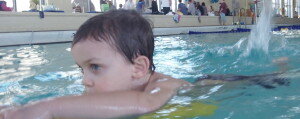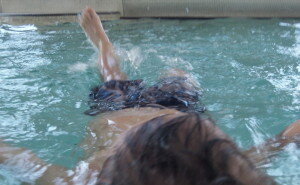Maximo "Overconfidence" (3 years old)
It can happen so fast. One second, he's bouncing up and down, laughing and having the best time in the world. Then the pool gets deep enough that he can't touch the bottom and the panic sets in. Maximo, like most three year old boys, is a ball of energy. As is his twin brother, Fin, whom I'll be blogging about next (#34). He loves to bounce and play and have a great time in the water... as long as he can touch the bottom. So, what happens if he falls into a pool or hops to a depth just below the reach of his toes?
My guess is that most people would see Max in the pool and think, "That boy knows how to swim" or "He's swimming." This is where the whole question of what 'swimming' is comes into the conversation. This is what really hit home with Cindy, Participant #30. I told her to look around the pool and tell me how many people were actually 'swimming' by her definition- face in the water, moving through the water in a horizontal position. Very few. Dictionary definitions for 'swimming' give me: "to move along in water by means of movements of the body or parts of the body, esp the arms and legs," "to play in the water (as at a beach or swimming pool)," "to move with a motion like that of swimming," "not sink." As you'll see from the video at the bottom, Max is completely wet, happy, moving through the water, etc. He can't 'swim.' But he thinks he can, which makes a fun day at the pool a very dangerous situation.
Max loves the pool. He puts his face under, then stands up to breathe. He takes for granted that he can touch the bottom of the pool. He doesn't realize that the pool gradually gets deeper and deeper. He'll swim with me, try new skills and let me take him a little bit out of his comfort zone. But, there's a very fine line between challenging him and pushing him too far and straight into tears. He usually says, "No" and crosses his arms across his chest right when he's about to break through a barrier. Max definitely keeps me on my toes. My number one concern is his safety, so I have to get creative and be strict, but fun.
Kids can be feisty, especially boys. So, rather than spend my time constantly disciplining, I feed off my student's behavior and work around him. I guess that's one of the wonderful things about having a private lesson. Some kids prefer a consistent routine. In Max's case, rather than trying to get him to do exactly what I want at that exact time, I watch what he's doing and take cues from him. I then turn whatever he's doing into a skill and build on his success.
For example, if we are done using the kickboard to do flutter kicks, but he clearly doesn't want to part with it, I'll tell him, "Okay, first we'll use the kickboard to do something really fun on your back, then we'll put it on the side and do our big ice cream scoop arms." I find that if I give 'first, then' directions and he knows exactly what is on the agenda, he'll be on board.
On the same note, sometimes I'll get a swimmer that is terrified of jumping into the pool from the edge. Rather than say, "Do you want to do jumps now?" (because I know what the answer will be), I say, "Okay, we can do one jump or two jumps. Your choice." I'm giving him some power over the situation. He makes the decision, but I win in the end because either way he still jumps :)
Something that's great about Max's parents is that they understand the importance of learning to swim and being safe. I ask them to go outside and get completely out of sight and they listen to me. They understand that they can watch from afar, but Max cannot see them or hear them. As long as that is the case, he's fine. So, here's our lesson...








